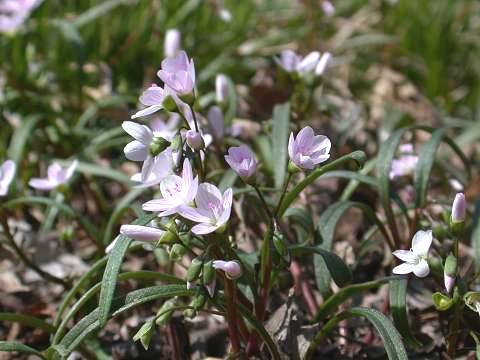

Claytonia virginica - (image 1 of 7)
Taxonomy
Family: Portulacaceae
Habitat
Woodlands, thickets, clearings; survives degradation.
Associates
Acer saccharum, Fraxinus americana, Geranium maculatum, Ostrya virginiana, Prunus serotina, Quercus alba, Quercus rubra, Tilia americana, Ulmus rubra, Viola pubescens Vitis riparia. In more mesic habitat found also found with Carex plantaginea, Dicentra canadensis, Dicentra cucullaria, Erythronium americanum, Fagus grandifolia, Lindera benzoin, Viburnum acerifolium.
Distribution
Nova Scotia west to MN, south to GA, LA, and TX.
Morphology
Low herbaceous plant from a rounded corm. Leaves 2-8" long, narrow, opposite in a single pair midway up stem. Flowers with 5 petals, white to pink with deeper pink stripes. Sepals 2, surrounding a small fruiting capsule at maturity.
Notes
Flowers mid March to mid June.
Wetland indicator: Facultative Upland.
A common spring ephemeral that is often found in large patches. Underground tuber edible. Does not form mycorrhizae.
References
Gleason, Henry A. and A. Cronquist. 1991. Manual of Vascular Plants of
Northeastern United States and Adjacent Canada. Second Ed.
The New York Botanical Garden. Bronx, NY
Swink, F. and G. Wilhelm. 1994. Plants of the Chicago Region.
Indiana Academy of Science. The Morton Arboretum. Lisle, Illinois.
|
Michael Hough © 2004 |